As an Amazon Associate I earn from qualifying purchases.
This is the best Canada goose breast recipe if you want to eat it like a steak or a London broil: Reverse seared goose breast, sliced thin and served simply.
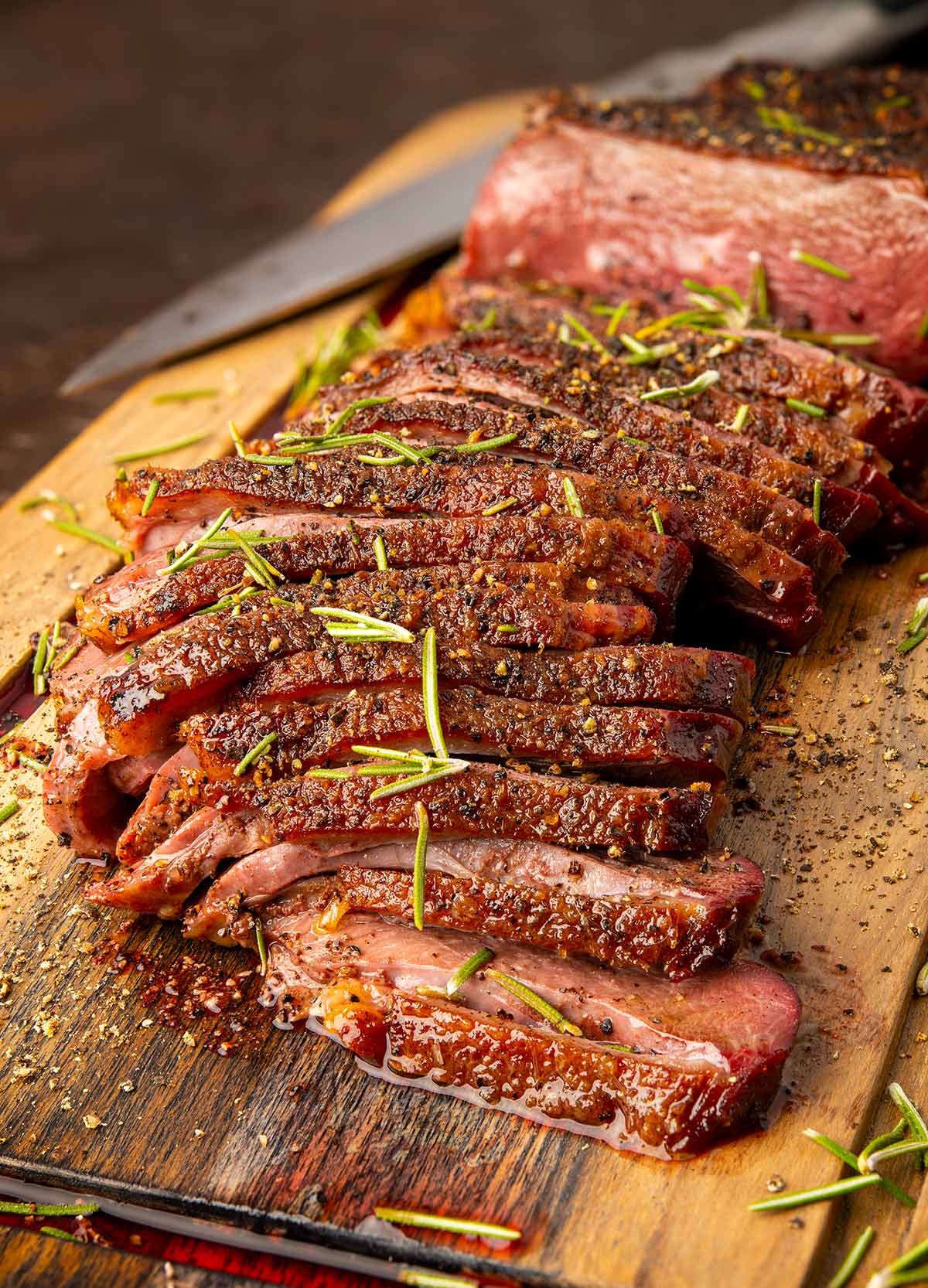
Cooking Canada geese can be problematic, and the birds have a bad reputation, both in life and on the plate. This is not entirely undeserved, but yes, you can eat Canada geese — and make them delicious.
Before we go any further, know that this goose breast recipe works with skin-on or skinless goose breast, with Canada geese or any other wild geese — specklebelly, snow, emperor, even swans — as well as with store-bought, farmed geese.
It is intended to combat the most common problem with cooking Canada goose breasts: Toughness.
Wild geese are far tougher than farmed for the simple reasons that 1) they fly around a lot, and 2) they can be incredibly old. Through leg band recovery data, the oldest known Canada goose was more than 33 years old! And it is not uncommon to shoot 10+ year-old geese on a daily basis during the season.
That’s a tough goose breast, one that needs just the right recipe.
The two regular rotation goose breast recipes I do are for goose pastrami and goose jerky. Both are excellent recipes for even ancient geese.
But sometimes you get a young goose, or one that isn’t obviously ancient. (Here’s a short guide to aging Canada geese in the feathers.) For that you’ll want this particular goose breast recipe: Slow-cooked to rare, then seared on one side crispy.
That’s really all this is. A typical reverse sear, in a smoker if you have one. I do this with elk roasts, as well as big, thick steaks like an elk or bison steak. It is an ideal method for cooking large hunks of red meat perfectly, and Canada goose breasts fit that bill.
I use a probe thermometer to monitor temperature. I have one set up on my Traeger, but you can also buy a thermometer that has its own readout. Then you slowly cook the goose breast in the oven or smoker until the internal temperature hits about 120°F, and no more than 135°F.
Then you sear the skin, or the side the skin used to be on, hard to get a nice sear. Hit that side with black pepper and an herb of your choice while the meat is resting, then slice thin.
The thin slicing is key. Even a fairly young goose can be years old, far older than anything you’d buy in a market, so slicing it thin, like a classic London broil, shortens the meat fibers and makes the meat nice to eat, even if it isn’t meltingly tender.

Getting a Tender Goose Breast
The slower you get the goose breast to temperature, the tenderer it will be. I take the meat right out of the fridge and smoke it at low-ish temperatures, about 170°F, for several hours before it gets to the target temp. The reason to start the goose breast cold is so that it develops a nice smoke ring.
This particular goose breast recipe does lend itself to sous vide, too. I normally seal the meat and immerse it in 130°F water for 2 hours. If you want to go longer, you will need to hard sear the entire surface of the goose breast for food safety reasons. If that’s the route you go, I’d set the machine to 120°F.
Smoking is a better method here, however, because the smoke inhibits bacteria growth, is a hotter environment, so you can go longer, which will break down connective tissue more, and it adds nice smoke flavor.
Finishing
I sear Canada goose breasts hard in goose or duck fat, but any nice fat will do. You want the fat almost smoking, and the meat fairly dry. This gets a good sear fast so the interior of the meat doesn’t heat up too much.
While resting, I grind black pepper over the meat, then some chopped herbs. rosemary is my herb of choice here, but chopped sage, savory, lovage, parsley, or oregano are all good options. Maybe a squeeze of lemon right as you serve.
This is goose breast as steak, so eat it as such, with potatoes, crusty bread, maybe a horseradish sauce, and a simple salad or green thing alongside. Red wine is a must.
If you liked this recipe, please leave a ⭐️⭐️⭐️⭐️⭐️ rating and a comment below; I’d love to hear how everything went. If you’re on Instagram, share a picture and tag me at huntgathercook.
Seared Goose Breast
Ingredients
- 1 goose breast, both halves
- Salt and freshly ground black pepper
- 2 tablespoon minced fresh rosemary
Instructions
- Salt the goose breasts about an hour before you plan to cook them. Keep them in the fridge. Get your smoker or oven to about 175°F to 200°F. For smokers, I use cherry wood here, but use what you have. If you are cooking sous vide, get the water to 130°F and vacuum seal the goose breasts.
- Cook the goose, skin side up (whether or not the skin is still there) until the interior hits 120°F to 130°F. I use a probe thermometer to determine this. If you are using sous vide, this will take about 2 hours or so. It takes about the same time in a smoker, depending on weather and temperature of the smoker.
- When you are ready to sear, get some oil, duck fat or goose fat hot, almost smoking. Sear the skin side (again, whether the skin is still there or not) hard for about 3 minutes. I like to put a heavy weight, like a bacon press or a small cast iron pan, on the meat to keep it flat.
- Remove the goose breast, set it skin side up on a cutting board to rest, and grind black pepper over it. Sprinkle some rosemary on it, too. Slice very thin and serve.
Nutrition
Nutrition information is automatically calculated, so should only be used as an approximation.
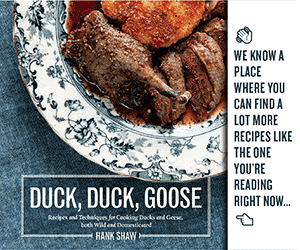
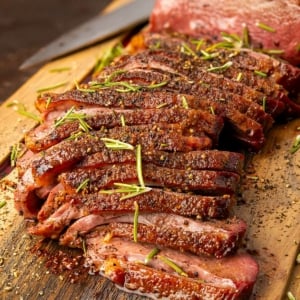

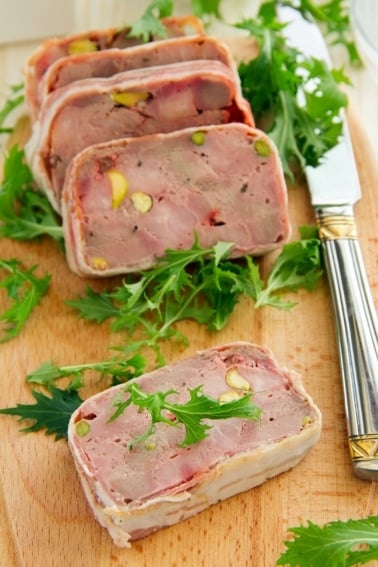

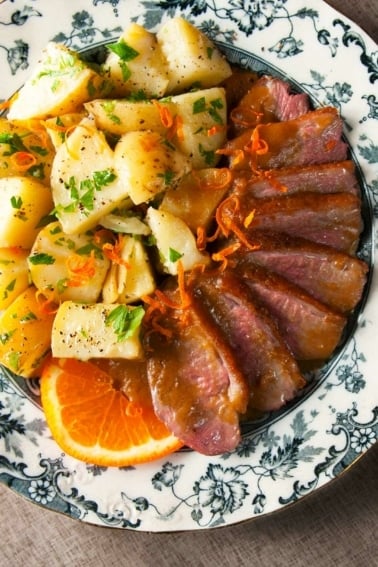
Awesome recipe! Even with no skin on the breast!
This is the only way I fix goose breasts. I have given the recipe out to many and have not gotten a negative response from anyone who has tried it.
I did the goose breasts.Salted them in the fridge for 1 hour, cooked them after seasoning for 1 hour to an internal temperature of 123 degrees at 175 degree oven in a 8×8 pyrex dish covered with aluminum foil. Then seared them 2 minutes per side, l;et stand 2 minutes and served. Kind of chewy on the outer edges where meat was cooked more. The centers were much like London Broil as you mentioned. I do not smoke anything, but I think it would be more tender possibly. This was a you Canadian goose I harvested last fall. On a scale of 1-5, I give this a 3-3.5. I would like to see more tender meat. I have to admit though, fresh fish has always been my favorite of all game dinner items.
You are my go to Guy for pretty much everything to do with wild food, and I am looking forward to cooking my Gray leg goose breast on my broiler tomorrow as a result. Many thanks as always, Hank
We were gifted two fresh breasts and having never cooked (or tasted) goose before we tried your oven method and it turned out so good! The meat was tender and the rosemary was perfect. We would definitely use this recipe again!
This recipe is spot on. I chose to sous vide for 2 hours at 130 degrees. Then I did a quick 60-90 second sear in cast iron. Then I seasoned as it rested. After the rest, I sliced thinly and served. I was really surprised. It was very good! Thanks Hank!
If any geese fly low enough over our Ranch here in Texas I’ll try this recipe in the smoker. I love mesquite smoked meat!
Hank ,
Awesome ! I have been hunting giant Canadas for 40 years or more and turne most into jerky till now.I sou vide the breast for 2.5 hours at 125. I soaked overnight in orange juice rinsed the best off and applied rotisserie chicken rub liberty .When finished I seared with duck fat .Wow. Sliced thin this old honker was tender and tasty . My new favorite thank you Mark Ohio
Really enjoyed this with a farmed goose I picked up at the farmer’s market. My Traeger isn’t great at holding low temps so I had to pull the breasts a good bit before 2 hours, but there was still a decent amount of smoke flavor in them. I’ll be trying the duck noodle soup recipe next with the remainder of the bird. Thanks Hank!
Hi Hank ,
Tried it with a specklbelly goose . Best goose a ate in a while ; Very tender and not ‘gamey ‘ at all . I,m a hunter from the north part of The Netherlands ; A province thats called Fryslan . We have a lot of geese over here ; Specks , greylags , barnacle , pinkfoots en even Canadageese . You, re book duck, duck goose is also very good .
Greetings from Fryslan ,
Perfect timing! I just returned from Alberta with a dozen skinless honker breasts. I’ve made your pastrami and jerky recipe in the past, but really look forward to this recipe. Many thanks.
Such an excellent recipe post for the long lived and ever multiplying Canada geese! Will try this on the next goose!
Thanks!
I have used this method for many decades and it is my favorite way to make geese.
OMG! To die for!
I served it up with some thinly sliced toasted French bread & a horseradish sauce.
Because I used the breasts from a smaller younger Canada goose it reached desired temperature much quicker than expected in the smoker, so it became brunch instead of lunch ?